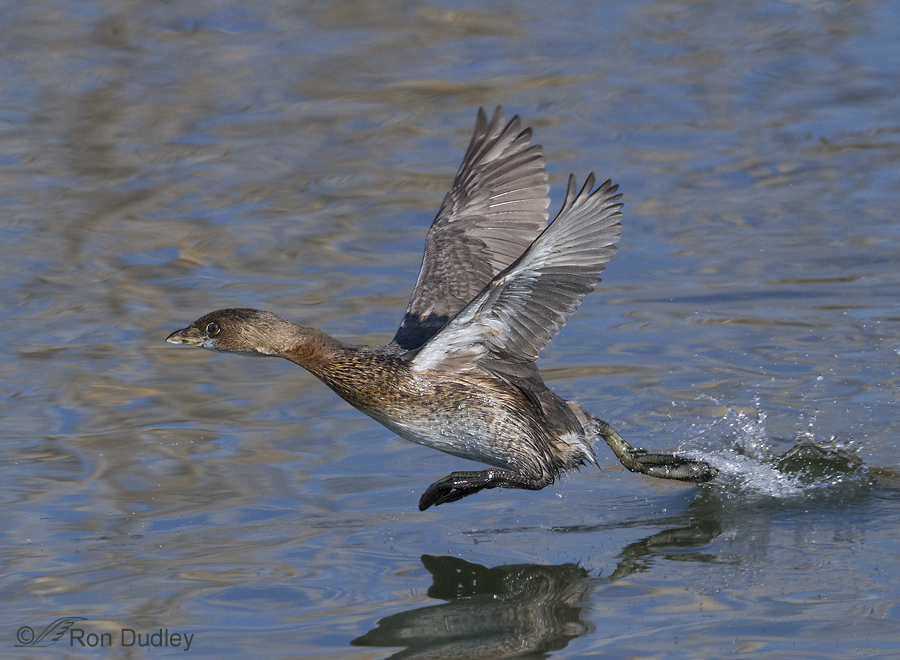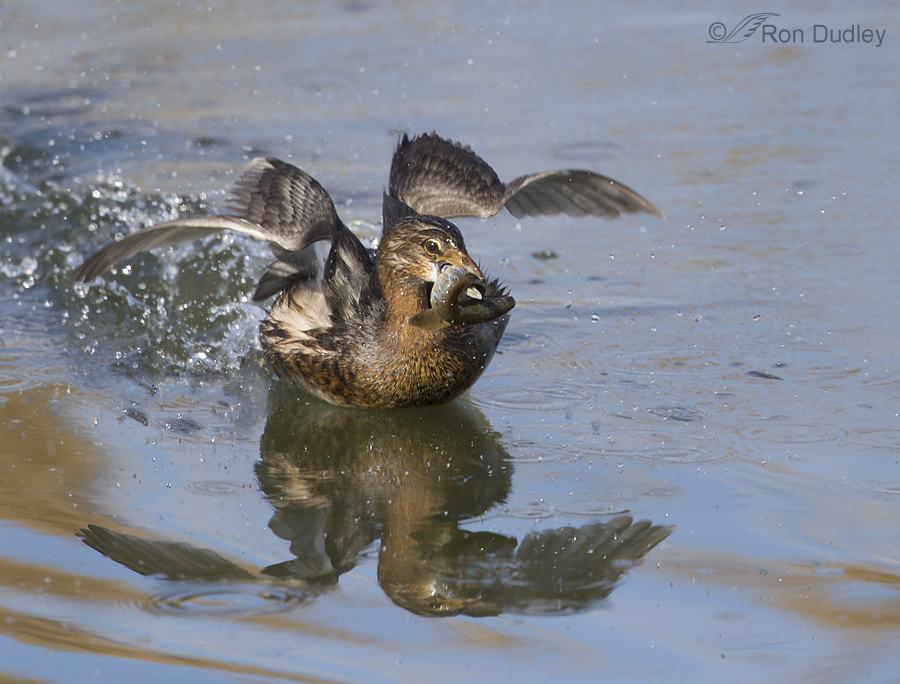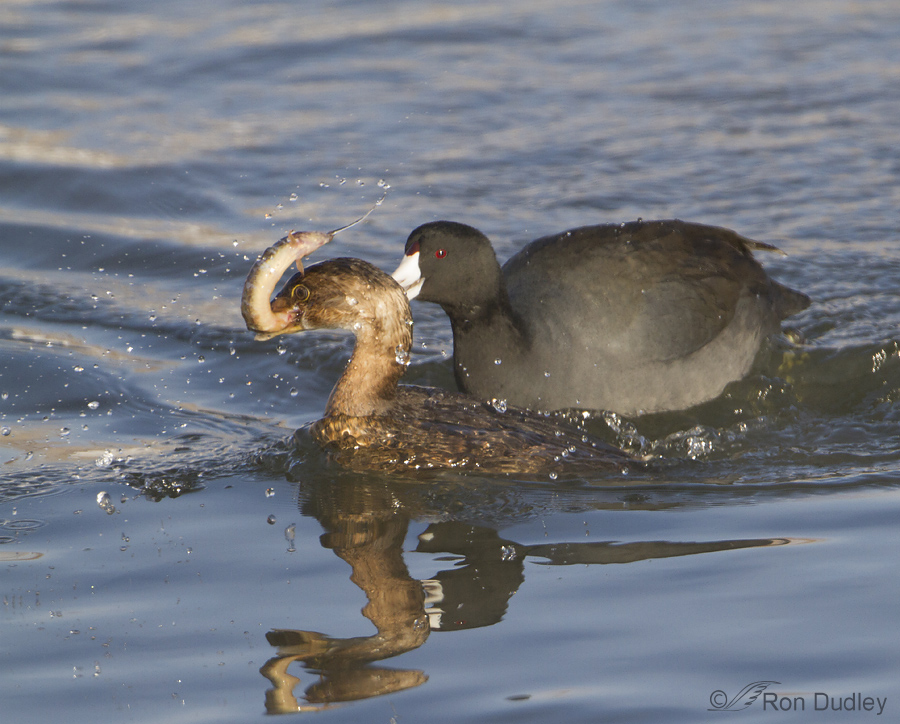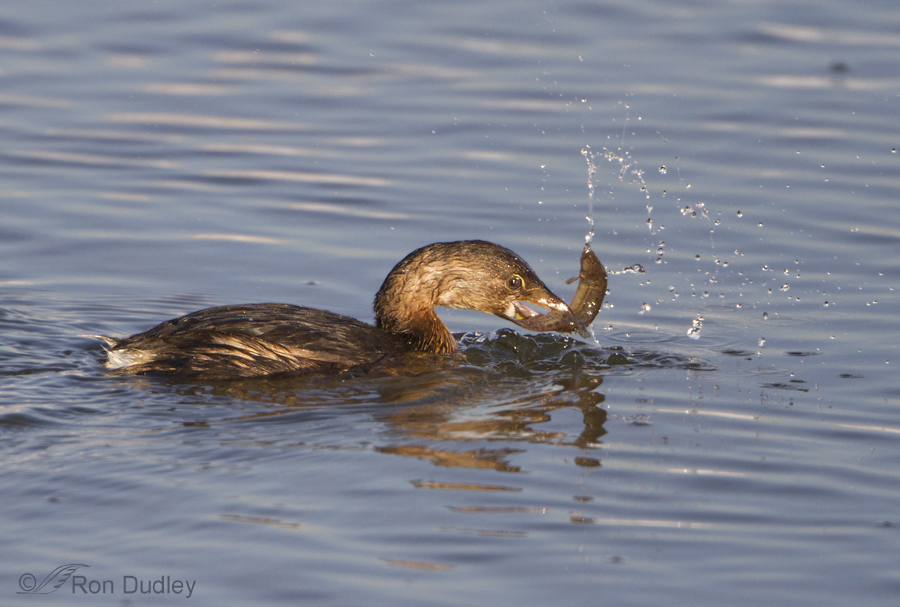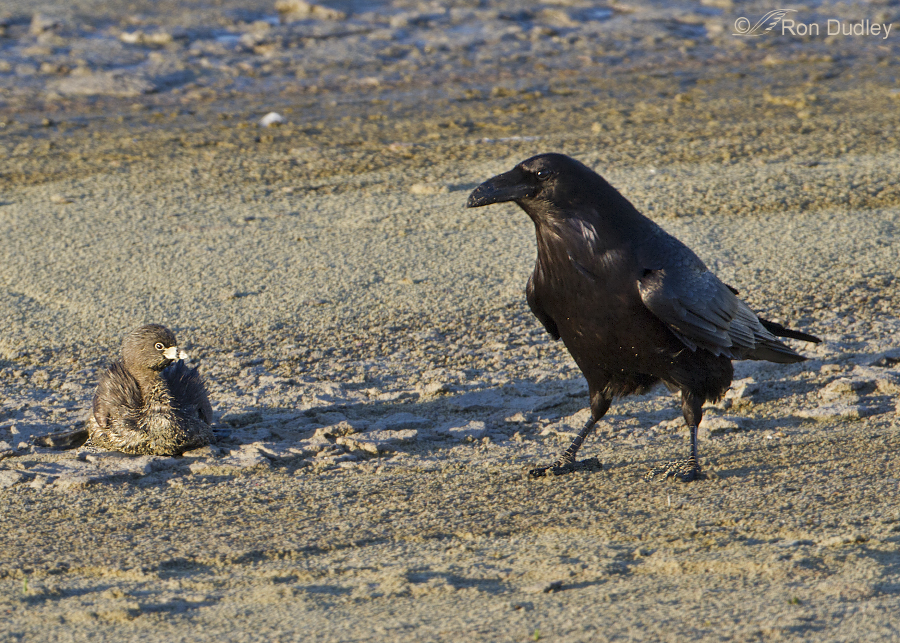Category: Pied-billed Grebes
Pied-billed Grebes Frantically Protecting Their Fish
A Coot In Pursuit Of A Grebe’s Fish
Pied-billed Grebe Feeding Behavior And An Invasive Species
Grebe Running Across A Pond’s Surface To Protect Its Prized Fish
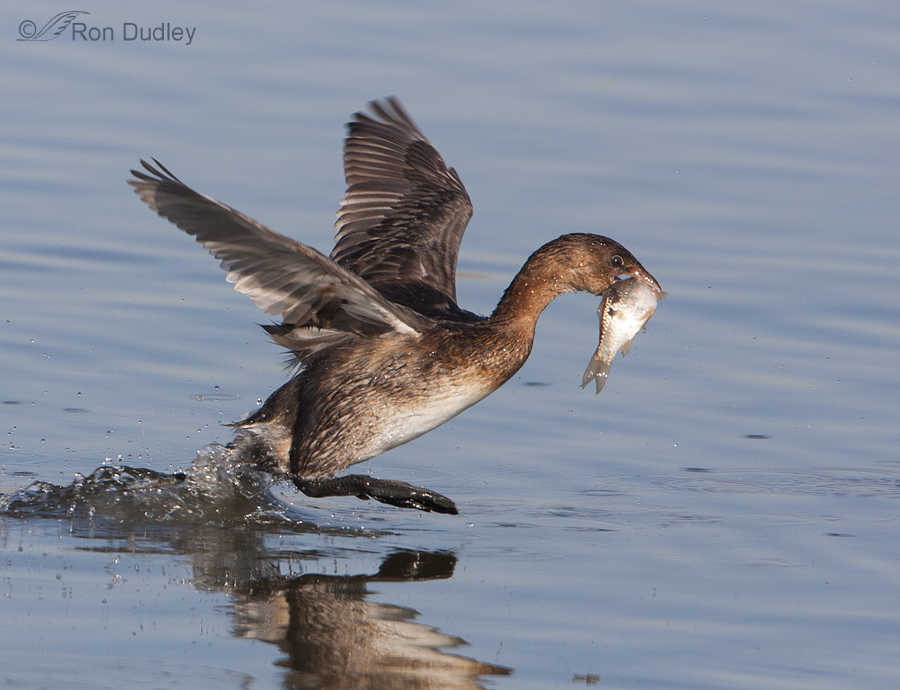
At first glance Pied-billed Grebes may come across as nondescript, bland little birds without much personality but I’ve found the opposite to often be true. When they’re not resting or grooming they’re active, quite vocal and when they’re feeding in groups they’re often aggressive, even pugnacious. Their kleptoparasitic tendencies can be entertaining to watch in the extreme.
Notice the layer of ice at the bottom of the frame – that ice will come into play later in the sequence.
Pied-billed Grebe On Nest
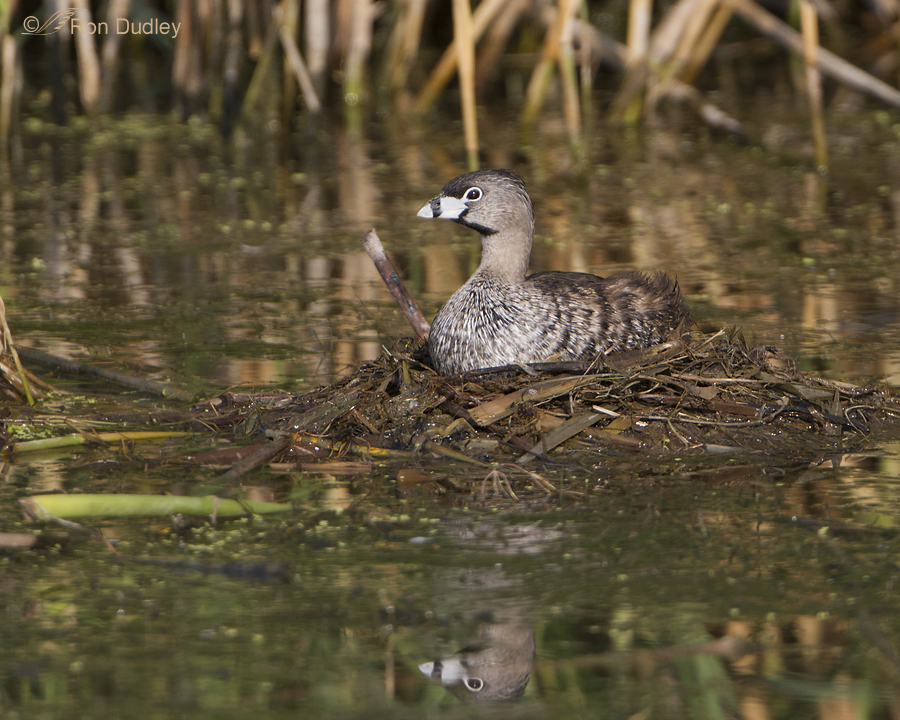
Yesterday morning I was very surprised to see this active nest so close to the loop road at Bear River Migratory Bird Refuge. Both parents incubate and the sexes are similar so I don’t know if this was the male or the female but the apparent mate of this bird was hanging around in the general vicinity.
The Raven And The Pied-billed Grebe
A Couple Of Interesting Pied-billed Grebe Behaviors
I love watching and photographing these small grebes because their pugnacious behaviors produce some fascinating interactions. They just may be the most aggressive bird species I’ve ever photographed.
A Pied-billed Grebe Attempts To Dismember A Frog
Pied-billed Grebes are opportunistic feeders, taking large crustaceans (especially crayfish), fish, insects and other invertebrates. They also consume a lot of frogs when they’re available. When the prey is too large to swallow whole (frogs and crayfish especially) they grasp the appendages with their beak and shake it vigorously until the limbs break off. I’ve also seen adults tear off bits of the body trunk of frogs to feed to their chicks. This bird is a juvenile, still learning the finer points of consuming prey. This stage of plumage development is referred to as the “stripe-head stage”, for obvious reasons. Adults lose those stripes. The frog it has captured is probably one of the first amphibians the bird has had to deal with without assistance from a parent and that inexperience seemed obvious as the young bird dealt with the frog. I’ve presented all the photos in this series in the order they were taken. As you can see, the young frog hasn’t yet fully metamorphosed into an adult and retains the tadpole tail. The grebe would repeatedly grasp a limb (it tried all 5 of them several times)… and then shake the frog violently in an apparent attempt to tear the appendage off like it has seen its parents do so many times before. Here it’s working on the left front leg. Other times the bird would grasp the body and shake. Hard! At times the grebe would appear to rest and “think” about its…
A Gluttonous Pied-billed Grebe
Pied-billed Grebes are opportunistic feeders so they’re not very fussy about what they eat, but they do seem particularly fond of crayfish, fish and frogs (including tadpoles). Before consuming crayfish and frogs (both are often too large to swallow whole) they rip them apart in an incredibly rapid shaking frenzy that tears off limbs and pieces before they’re swallowed (something I’ve documented here with a frog). They have very strong jaw muscles and before swallowing fish they repeatedly pinch them with their beak, which kills them by damaging their internal organs. Occasionally, when choosing prey, their eyes are bigger than their stomachs – as you’re about to see. (all images are presented in the order that they occurred) All images presented in this post had the following techs: f/6.3, ISO 500, 500 f/4, 1.4 tc, shutter speed ranged from 1/2000 to 1/1250 Last winter, I noticed this grebe just after it surfaced with a fish. A very large fish, at least relative to the size of the bird who must now swallow it. (I’ve never seen one tear a fish into smaller pieces before eating it). As a side-note, I liked the “extra eye” in the reflection at the bottom of the frame. I thought this image would give the viewer a good sense for the size of the fish – especially its width! But the poor bird didn’t have any time at all to get the meal down before other grebes rushed in to try to steal the fish. The competition at times like this is…
Pied-billed Grebe Showing Off A Little
I’ve always thought of Pied-billed Grebes as sort of the Rodney Dangerfields of the bird world because they just “don’t get no respect”. At least they don’t get as much as I think they deserve from bird photographers. They’re plain little brown birds, very common (in fact they’re the most widely distributed grebe species in North America) and often when they’re seen they’re just sitting calmly on the water so many photographers usually ignore them. But if you spend enough time with them it won’t be long till you see that they’re full of personality and interesting behaviors. They’re pugnacious, aggressive and extremely active in bursts. I enjoy the heck out of them. 1/1600, f/6.3, ISO 500, 500 f/4, 1.4 tc, natural light, not baited, set up or called in While I was watching this bird float effortlessly on the water it began to rouse (ruffle its feathers). Sometimes rousing is a precursor to a wing flap so this time… 1/1600, f/6.3, ISO 500, 500 f/4, 1.4 tc, natural light, not baited, set up or called in I was ready when it happened. When grebes do a wing flap they raise their chubby little bodies out of the water. 1/1600, f/6.3, ISO 500, 500 f/4, 1.4 tc, natural light, not baited, set up or called in This one didn’t last long and here the bird is already beginning to settle back onto the water. 1/1600, f/6.3, ISO 500, 500 f/4, 1.4 tc, natural light, not baited, set up or called in…
Some Recent Shots I Like, Despite Some Flaws
Like every other bird photographer many of the photos I take are not worth keeping. For the first few years I was shooting birds I estimated that I deleted 90% of my images. Now that I’ve become a little more discriminating that number is probably closer to 95%. Birds are incredibly difficult subjects – they’re fast, unpredictable, difficult to approach and generally uncooperative. When I’m culling images after a day in the field most shots fall under two main categories – keepers and garbage. But there’s often a few that are technically lacking for one reason or another but have some unusual or especially interesting feature that makes it difficult for me to trash them. So I don’t. Occasionally I go back through them just for the fun of it. I enjoy them and thought some of you might too so here’s a few from the past month or so. 1/2500, f/7.1, ISO 500 500 f/4, 1.4 tc This one’s from yesterday – a Lark Sparrow that posed and groomed for us for quite a while. Looking through the viewfinder I had no idea there was a second Lark Sparrow in the vicinity and didn’t even notice it flying through the frame until I got home and looked at it on my computer. Mia said that she’d noticed the second bird and that it chased the first bird away when it flew. Anyway, I thought the out-of-focus sparrow to the left was an interesting serendipity. I just wish the two twigs by the head weren’t there. 1/2500, f/7.1, ISO 500 500 f/4, 1.4…
Pied-billed Grebe Feeding Behaviors
Pied-billed Grebes are fascinating little birds with a chip on their shoulders. They are pugnacious, full of personality and quite small. They don’t seem to get a lot of attention from bird photographers, possibly because of their generally drab colors and because they’re so common. I really enjoy watching and photographing their behaviors. I’ve stated here before that “behavior” is a major focus of this blog and if I have images of interesting behaviors that are less than perfect technically I will still post them if they illustrate the behavior well. There are several in that category in this post. Grebe with young carp Carp are the primary food for these birds in many of the ponds I frequent. Even young fish can make a huge mouthful for these very small grebes. Swallowing a carp I’ve seen it take several minutes for a grebe to finally work one of these huge (for them) fish down their throats. And I’ve yet to see one give up on the meal because it’s too big. A slippery meal Fish are slimy and slippery and sometimes get away from the grebe temporarily, though they always seem to be recaptured. A potential thief in the background These birds are very social so there’s nearly always other grebes close by when one catches a meal and some of them will invariably try to steal the prize from its rightful owner. This can make for some very interesting but challenging encounters for the photographer because the action is usually so…
Why Grebes Eat Feathers
Grebes, as a group, are known for eating feathers – usually their own. The obvious question is – why? There would be virtually no nutritional value in a feather. Clark’s Grebe eating a feather I’ve photographed four species of grebes – Western Grebe, Clarks Grebe (these two are very similar), Pied-billed Grebe and Eared Grebe. I’ve been able to document feather eating in all but the Eared Grebe. Western Grebe parent feeding feather to young Over a period of perhaps a half hour I watched this adult feed several feathers to the chicks, who seemed almost as eager to consume the feathers as they did the fish provided by the parents. Western Grebe chick reaching for a feather from its parent Feathers are fed to the young almost immediately after hatching. In fact, feathers are very often the first item eaten by newly hatched chicks of many grebe species. The purpose(s) of feather eating is unproven but evidence suggests that the behavior has these benefits for the birds. Some of the ingested feathers form a plug in the pylorus, between the stomach and small intestine, which acts as a strainer to keep fish bones in the stomach long enough to be completely digested. Most swallowed feathers end up in the stomach lumen, mixed with food. They eventually (along with any indigestible matter) form pellets that are ejected through the mouth. The continuous passage of these pellets through the upper digestive system minimizes the buildup of a variety of parasites that are very common there and plague grebes. Pied-billed…
Pied-billed Grebes Frantically Protecting Their Fish
A Coot In Pursuit Of A Grebe’s Fish
Pied-billed Grebe Feeding Behavior And An Invasive Species
Grebe Running Across A Pond’s Surface To Protect Its Prized Fish

At first glance Pied-billed Grebes may come across as nondescript, bland little birds without much personality but I’ve found the opposite to often be true. When they’re not resting or grooming they’re active, quite vocal and when they’re feeding in groups they’re often aggressive, even pugnacious. Their kleptoparasitic tendencies can be entertaining to watch in the extreme.
Notice the layer of ice at the bottom of the frame – that ice will come into play later in the sequence.
Pied-billed Grebe On Nest

Yesterday morning I was very surprised to see this active nest so close to the loop road at Bear River Migratory Bird Refuge. Both parents incubate and the sexes are similar so I don’t know if this was the male or the female but the apparent mate of this bird was hanging around in the general vicinity.
The Raven And The Pied-billed Grebe
A Couple Of Interesting Pied-billed Grebe Behaviors
I love watching and photographing these small grebes because their pugnacious behaviors produce some fascinating interactions. They just may be the most aggressive bird species I’ve ever photographed.
A Pied-billed Grebe Attempts To Dismember A Frog
Pied-billed Grebes are opportunistic feeders, taking large crustaceans (especially crayfish), fish, insects and other invertebrates. They also consume a lot of frogs when they’re available. When the prey is too large to swallow whole (frogs and crayfish especially) they grasp the appendages with their beak and shake it vigorously until the limbs break off. I’ve also seen adults tear off bits of the body trunk of frogs to feed to their chicks. This bird is a juvenile, still learning the finer points of consuming prey. This stage of plumage development is referred to as the “stripe-head stage”, for obvious reasons. Adults lose those stripes. The frog it has captured is probably one of the first amphibians the bird has had to deal with without assistance from a parent and that inexperience seemed obvious as the young bird dealt with the frog. I’ve presented all the photos in this series in the order they were taken. As you can see, the young frog hasn’t yet fully metamorphosed into an adult and retains the tadpole tail. The grebe would repeatedly grasp a limb (it tried all 5 of them several times)… and then shake the frog violently in an apparent attempt to tear the appendage off like it has seen its parents do so many times before. Here it’s working on the left front leg. Other times the bird would grasp the body and shake. Hard! At times the grebe would appear to rest and “think” about its…
A Gluttonous Pied-billed Grebe
Pied-billed Grebes are opportunistic feeders so they’re not very fussy about what they eat, but they do seem particularly fond of crayfish, fish and frogs (including tadpoles). Before consuming crayfish and frogs (both are often too large to swallow whole) they rip them apart in an incredibly rapid shaking frenzy that tears off limbs and pieces before they’re swallowed (something I’ve documented here with a frog). They have very strong jaw muscles and before swallowing fish they repeatedly pinch them with their beak, which kills them by damaging their internal organs. Occasionally, when choosing prey, their eyes are bigger than their stomachs – as you’re about to see. (all images are presented in the order that they occurred) All images presented in this post had the following techs: f/6.3, ISO 500, 500 f/4, 1.4 tc, shutter speed ranged from 1/2000 to 1/1250 Last winter, I noticed this grebe just after it surfaced with a fish. A very large fish, at least relative to the size of the bird who must now swallow it. (I’ve never seen one tear a fish into smaller pieces before eating it). As a side-note, I liked the “extra eye” in the reflection at the bottom of the frame. I thought this image would give the viewer a good sense for the size of the fish – especially its width! But the poor bird didn’t have any time at all to get the meal down before other grebes rushed in to try to steal the fish. The competition at times like this is…
Pied-billed Grebe Showing Off A Little
I’ve always thought of Pied-billed Grebes as sort of the Rodney Dangerfields of the bird world because they just “don’t get no respect”. At least they don’t get as much as I think they deserve from bird photographers. They’re plain little brown birds, very common (in fact they’re the most widely distributed grebe species in North America) and often when they’re seen they’re just sitting calmly on the water so many photographers usually ignore them. But if you spend enough time with them it won’t be long till you see that they’re full of personality and interesting behaviors. They’re pugnacious, aggressive and extremely active in bursts. I enjoy the heck out of them. 1/1600, f/6.3, ISO 500, 500 f/4, 1.4 tc, natural light, not baited, set up or called in While I was watching this bird float effortlessly on the water it began to rouse (ruffle its feathers). Sometimes rousing is a precursor to a wing flap so this time… 1/1600, f/6.3, ISO 500, 500 f/4, 1.4 tc, natural light, not baited, set up or called in I was ready when it happened. When grebes do a wing flap they raise their chubby little bodies out of the water. 1/1600, f/6.3, ISO 500, 500 f/4, 1.4 tc, natural light, not baited, set up or called in This one didn’t last long and here the bird is already beginning to settle back onto the water. 1/1600, f/6.3, ISO 500, 500 f/4, 1.4 tc, natural light, not baited, set up or called in…
Some Recent Shots I Like, Despite Some Flaws
Like every other bird photographer many of the photos I take are not worth keeping. For the first few years I was shooting birds I estimated that I deleted 90% of my images. Now that I’ve become a little more discriminating that number is probably closer to 95%. Birds are incredibly difficult subjects – they’re fast, unpredictable, difficult to approach and generally uncooperative. When I’m culling images after a day in the field most shots fall under two main categories – keepers and garbage. But there’s often a few that are technically lacking for one reason or another but have some unusual or especially interesting feature that makes it difficult for me to trash them. So I don’t. Occasionally I go back through them just for the fun of it. I enjoy them and thought some of you might too so here’s a few from the past month or so. 1/2500, f/7.1, ISO 500 500 f/4, 1.4 tc This one’s from yesterday – a Lark Sparrow that posed and groomed for us for quite a while. Looking through the viewfinder I had no idea there was a second Lark Sparrow in the vicinity and didn’t even notice it flying through the frame until I got home and looked at it on my computer. Mia said that she’d noticed the second bird and that it chased the first bird away when it flew. Anyway, I thought the out-of-focus sparrow to the left was an interesting serendipity. I just wish the two twigs by the head weren’t there. 1/2500, f/7.1, ISO 500 500 f/4, 1.4…
Pied-billed Grebe Feeding Behaviors
Pied-billed Grebes are fascinating little birds with a chip on their shoulders. They are pugnacious, full of personality and quite small. They don’t seem to get a lot of attention from bird photographers, possibly because of their generally drab colors and because they’re so common. I really enjoy watching and photographing their behaviors. I’ve stated here before that “behavior” is a major focus of this blog and if I have images of interesting behaviors that are less than perfect technically I will still post them if they illustrate the behavior well. There are several in that category in this post. Grebe with young carp Carp are the primary food for these birds in many of the ponds I frequent. Even young fish can make a huge mouthful for these very small grebes. Swallowing a carp I’ve seen it take several minutes for a grebe to finally work one of these huge (for them) fish down their throats. And I’ve yet to see one give up on the meal because it’s too big. A slippery meal Fish are slimy and slippery and sometimes get away from the grebe temporarily, though they always seem to be recaptured. A potential thief in the background These birds are very social so there’s nearly always other grebes close by when one catches a meal and some of them will invariably try to steal the prize from its rightful owner. This can make for some very interesting but challenging encounters for the photographer because the action is usually so…
Why Grebes Eat Feathers
Grebes, as a group, are known for eating feathers – usually their own. The obvious question is – why? There would be virtually no nutritional value in a feather. Clark’s Grebe eating a feather I’ve photographed four species of grebes – Western Grebe, Clarks Grebe (these two are very similar), Pied-billed Grebe and Eared Grebe. I’ve been able to document feather eating in all but the Eared Grebe. Western Grebe parent feeding feather to young Over a period of perhaps a half hour I watched this adult feed several feathers to the chicks, who seemed almost as eager to consume the feathers as they did the fish provided by the parents. Western Grebe chick reaching for a feather from its parent Feathers are fed to the young almost immediately after hatching. In fact, feathers are very often the first item eaten by newly hatched chicks of many grebe species. The purpose(s) of feather eating is unproven but evidence suggests that the behavior has these benefits for the birds. Some of the ingested feathers form a plug in the pylorus, between the stomach and small intestine, which acts as a strainer to keep fish bones in the stomach long enough to be completely digested. Most swallowed feathers end up in the stomach lumen, mixed with food. They eventually (along with any indigestible matter) form pellets that are ejected through the mouth. The continuous passage of these pellets through the upper digestive system minimizes the buildup of a variety of parasites that are very common there and plague grebes. Pied-billed…


